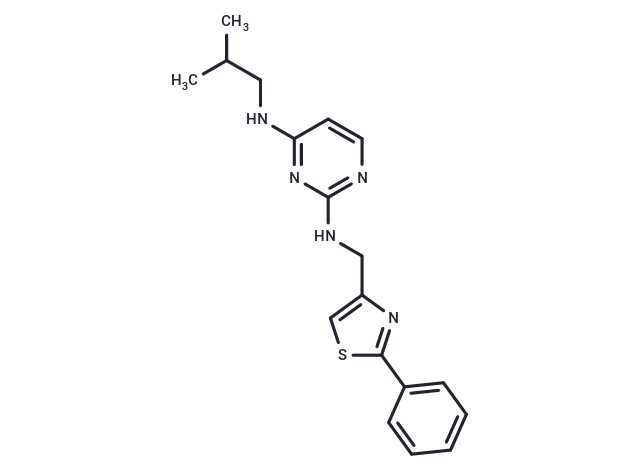Shopping Cart
- Remove All
 Your shopping cart is currently empty
Your shopping cart is currently empty

KHS101 is a novel inhibitor of transforming acidic coiled-coil protein 3 (TACC3). It is a selective inducer of neuronal differentiation.

| Pack Size | Price | Availability | Quantity |
|---|---|---|---|
| 1 mg | $44 | In Stock | |
| 5 mg | $98 | In Stock | |
| 10 mg | $142 | In Stock | |
| 25 mg | $226 | In Stock | |
| 50 mg | $351 | In Stock | |
| 100 mg | $526 | In Stock |
| Description | KHS101 is a novel inhibitor of transforming acidic coiled-coil protein 3 (TACC3). It is a selective inducer of neuronal differentiation. |
| In vitro | KHS101 increased neuronal differentiation of adherently cultured rat NPCs in a dose-dependent fashion (EC50 ~ 1 μM). KHS101-induced neuron formation (40–60% TuJ1+ cells at 1.5–5 μM KHS101) was also observed under neurosphere-forming conditions in secondary neurospheres derived from both the hippocampus and the subventricular zone (SVZ) of adult rats [2]. SMMC-7721 and SK-Hep-1 cells were cultured with different KHS101 concentrations (40 μM and 20 μM, respectively) to determine the IC50 values. The number and size of spheres were significantly decreased after treatment with KHS101 compared with the control (DMSO) treatment. Sphere formation was dependent on the KHS101 concentration. Bmi1, c-Myc, and Nanog were all decreased in the presence of KHS101. Compared with the control (DMSO), KHS101 decreases the expression of p-AKT, p-GSK3β and β-catenin, as well as the expression of the downstream markers c-Myc and cyclin D1 [2]. |
| In vivo | The doses of 6 mg/kg KHS101 (i.v. and s.c.) resulted in reasonable plasma concentrations (>1.5 μM) with a plasma half-life of 1.1–1.4 h, and relative bioavailability of 69% following s.c. dosing. Most importantly, the distribution of KHS101 to the brain was extensive as demonstrated by a brain-to-plasma AUC(0–3h) ratio of ~8 (dosing: 3 mg/kg KHS101, i.v.) [1]. |
| Kinase Assay | NPC lysate was prepared by sonication in PBS and protein samples were prepared at a concentration of 2 mg/mL. The benzophenone-KHS101 compound (KHS101-BP, 5 μM) was added to 50 μL of the proteome reaction with and without unlabeled compound (250 μM). Irradiation was for 1 h using a hand-held UV lamp at long wavelength (365 nm), and subsequently, a copper-catalyzed azide-alkyne cycloaddition reaction was performed. After incubation for 1 h at RT, proteins were precipitated using trichloroacetic acid and resuspended in isoelectric focusing sample buffer. 2D SDS/PAGE was performed using ReadyStripe IPG stripes following the manufacturer's protocol [1]. |
| Cell Research | Rat NPCs were derived and cultured as described previously by others. After hippocampal cell isolation, the number of dissociated cells was determined and ~5 × 10^5 cells were plated in 60-mm uncoated plates. After overnight incubation (37 °C, 5% CO2, and 95% humidity), the medium was changed and the cells were expanded and maintained in an undifferentiated state on polyornithine- (10 μg/mL in water) and laminin-coated (5 μg/mL in PBS;) dishes in DMEM/F12 supplemented with N2 and basic fibroblast growth factor (bFGF, 20 ng/mL;). For KHS101 and shRNA-induction experiments, early passage cells (passaged no more than six times after hippocampal isolation) were trypsinized and plated at a density of ~1,000 cells/cm2 into N2 medium (DMEM/F12 supplemented with N2) containing KHS analogs (e.g., KHS101, KHS92, and NP; SI Text) at different concentrations (0.5–5 μM) or DMSO (0.1%), RA (1–2 μM), BDNF (100 ng/mL), and/or BMP4 (50–100 ng/mL) for 4 d [1]. |
| Animal Research | To investigate the pharmacokinetic properties of KHS101, male Sprague–Dawley rats were administered 3 mg/kg KHS101 i.v. or s.c. One rat was killed per time point at 5 min, 40 min, 1 h, and 3 h after dosing, and samples of blood (100 μL) and whole brains were collected. In a separate study, rats were administered 6 mg/kg KHS101 i.v. or s.c. Five blood samples of 100 μL each were collected serially via a jugular vein catheter at 2 min (i.v. only), 0.5 h (s.c. only), and 1, 3, 7 and 24 h after dosing. Plasma and homogenized whole brain samples were analyzed by liquid chromatography-tandem mass spectrometry (LC-MS/MS). To study neuronal differentiation upon KHS101 administration in vivo, adult Fisher 344 rats (~10 wk old) received s.c. injections of 6 mg/kg KHS101 or vehicle control (5% ethanol in 15% Captisol). All rats received one daily i.p. injection of 200 mg/kg BrdU for 6 consecutive days after the first day. After 14 d, the animals were killed and perfusion fixed, and the brains were removed and subjected to immunohistochemical analysis [1]. |
| Molecular Weight | 339.46 |
| Formula | C18H21N5S |
| Cas No. | 1262770-73-9 |
| Smiles | C(NC=1N=C(NCC(C)C)C=CN1)C=2N=C(SC2)C3=CC=CC=C3 |
| Relative Density. | 1.241 g/cm3 (Predicted) |
| Storage | Powder: -20°C for 3 years | In solvent: -80°C for 1 year | Shipping with blue ice. | ||||||||||||||||||||||||||||||||||||||||
| Solubility Information | Ethanol: 15 mg/mL (44.19 mM), Sonication is recommended. DMSO: 60 mg/mL (176.75 mM), Sonication is recommended. | ||||||||||||||||||||||||||||||||||||||||
Solution Preparation Table | |||||||||||||||||||||||||||||||||||||||||
Ethanol/DMSO
DMSO
| |||||||||||||||||||||||||||||||||||||||||

Copyright © 2015-2025 TargetMol Chemicals Inc. All Rights Reserved.